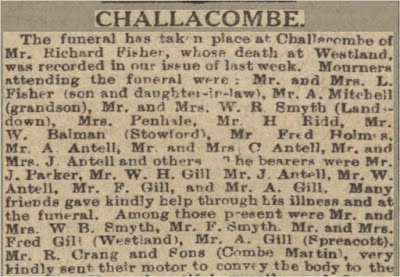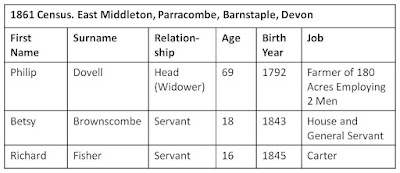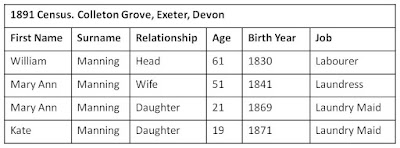My Great x3 Grandfather William (1830 - 1895) was a soldier, general labourer and father of nine.
William Manning was born around 1830 in Spreyton, Devon, to William Manning (between 34 and 38 years old), an agricultural labourer, and Mary Manning (nee Westcott) (about 34).
William was baptised on 18th April 1830 in Spreyton.
William was the sixth of eight children (four sons and four daughters):
- Samuel 1822 -
- Eliza 1823 - 1824 (1 years old)
- Harriot 1825 -
- Mary Ann 1826 -
- Benjamin 1828 -
- William 1830 -
- Thomas 1831 -
- Eliza 1834 -
Times were for a while tough: unlike her older sibling's baptism records, the 1834 baptism record of William's young sister Eliza gives their abode as alas the poor house. Hopefully the family, including little William, were not there long. By the time of the 1841 Census, seven years later, they are shown as not living in the poor house, but simply Spreyton village.
1841 Census:
Two key things happened to teenage William and his family in the 1840's: firstly, at some point, his mother Mary passed away, as his father is listed as a widower on the 1851 Census; also William and his family, at some point, moved from his native Spreyton about sixteen miles east to Exeter.
The 1851 Census shows the family living on Smythen Street in Exeter's poor West Quarter. The homes of Smythen Street were mainly late medieval timber-fronted buildings, beautiful in their time, but by the Victorian era long-weathered and their inhabitants poor.
The top part of Smythen Street was known as Butchers' Row, where one side of the street was lined with many butchers' shops. The opening of the Lower Market in 1836, a purpose built space for the butchers of Exeter, marked the beginning of the end for Butchers' Row; however the 1851 Census shows that when William and his family lived there, some fifteen years after the opening of the Lower Market, many of their neighbours were still butchers.
1851 Census:
Neighbouring households were quite small, with only families, but the labouring Manning family appear to have been part-letting their home or running a lodging house, for they have ten persons listed as lodgers, including two small families, the Prideauxs and the Belworthys.
William's younger brother Thomas soon joined the army. He enlisted as a private on 6th February 1852, aged about twenty-one. He served in the Northamptonshire Regiment - 48th and 50th Foot. After thirteen years of service, most likely including the Crimean War, on 31st October 1865, he was found unfit for further service, due to suffering from abdominal aortic aneurysm (a painful enlargement of the body's main artery).
His record of dismissal describes his character and appearance...
"His character is good. Is in possession of the good conduct badge. [But] His name appears four times in regimental defaulters' book. He has been tried twice by court martial."
He was 5'9'', had a fresh complexion, grey eyes and brown hair. After scars or marks, it says he had the "letter D", most possibly tattooed somewhere upon his body. Did William look like his brother?
It seems William later joined the army too. He was in the South Devon Militia, before joining the 17th Reg of Foot. He enlisted as a private on 7th June 1858, aged about twenty-eight. After seven years of service, on 24th July 1865, he was found unfit for further service, due to suffering from all the signs of phthisis pulmonalis (tuberculosis).
His record of dismissal also describes his character and appearance...
"His character is good. Is not in possession of any good conduct badges. Was six times in the regimental defaulters' book. Was once tried by court martial."
He was 5'5'', had a fair complexion, hazel eyes and brown hair. Like his younger brother, he also had a mark of the 'letter D'. What did this D mean to them? Did it perhaps stand for Devon? Interestingly, William's listed intended place of residence after leaving the army is not his native Devon, but randomly in Bradford, Yorkshire. However, after leaving the army, he does not seem to have ended up in Bradford, but soon back down in Devon.
So William, suffering from tuberculosis, returned to his home county, in his mid thirties, in the mid 1860's. Soon he started a family. Interestingly, I cannot find a marriage certificate for William, who after the army worked as a labourer, and his laundress wife Mary Ann Manning (nee Ireland), but by mid 1864 they were certainly together, for by April 1865 (9 months later) their first child, Emma, was born in Exeter. Record of her baptism the next month in Exeter lists both parents.
William and Mary Ann had nine children (five daughters and four sons):
- Emma 1865 - 1866 (11 months)
- William 1868 -
- Mary Ann 'Polly' 1869 -
- Kate 1871 -
- Rose 1875 - 1877 (2 years old)
- Samuel 1877 - 1877 (11 weeks old)
- James 1879 - 1887 (7 or 8 years old)
- Unnamed Daughter 1880 - 1880 (0 years old)
- Frederick John 1882 - 1882 (6 weeks old)
Very sadly six (two thirds) of William and Mary Ann's children passed away in infancy. Their eldest child Emma passed away aged eleven months in 1866; over the next few years, they then had three children that survived into adulthood - William, Polly and Kate -; their fifth child Rose (two years old) and sixth child Samuel (eleven weeks old) both passed away in 1877; their seventh child James made it through his earliest years, but passed away aged seven or eight in 1887; their eighth child, an unnamed daughter, was born after a six months pregnancy in 1880 and passed away soon after; and their ninth and youngest child Frederick passed away at six weeks old in 1882.
Why did so many of William and Mary Ann's children pass away so young? My initial gut theory was syphilis, which can cause poor pregnancy outcomes. The mother can have many children, but few survive, as is the case here. However, William was dismissed from the army for showing signs of tuberculosis. Did his illness affect the survival of his children? Did he pass it on to them?
Most persons with tuberculosis in the 1800's did not live long with the disease; however, after showing signs in his mid thirties in the mid 1860's, William went on to have nine children, and live for another thirty years, into his mid sixties. I wonder: did he indeed have tuberculosis and was the anomaly who lived long with it? Or was he misdiagnosed and suffered after another condition from which he recovered and lived for many years, or could more likely survive with for many years? Yet, even back then, tuberculosis was well known and easily diagnosed.
Later censuses list William as a labourer, however the females in his family - his wife, mother in law, and daughters - are often listed as laundresses or laundry maids. Was it in fact the females' work that supported the family, whilst ill William did the little labour he could?
1871 Census:
1881 Census:
Jubilee Street, where the family lived, was at the bottom of Weirfield Road in Exeter, and consisted of rows of slum terraced houses, close to the River Exe. Sometime in the 1880's, William and his surviving family moved from Jubilee Street just around the corner to 4 Colleton Grove.
1891 Census:
The 1891 Census lists William's teenage daughter Kate as deaf.
In 1895, William passed away, aged sixty-five, in Exeter. He was buried on 9th March 1895 in Exeter.




















































